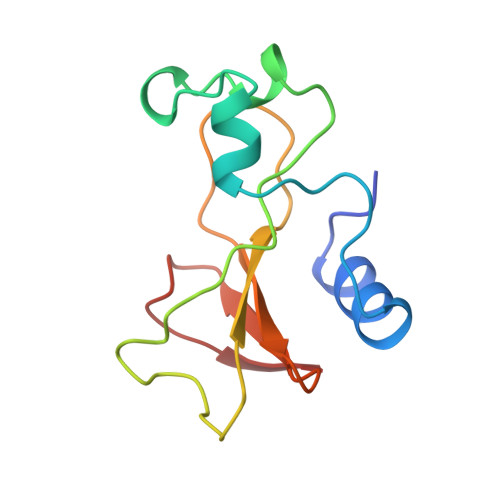Structural and energetic responses to cavity-creating mutations in hydrophobic cores: observation of a buried water molecule and the hydrophilic nature of such hydrophobic cavities.
Buckle, A.M., Cramer, P., Fersht, A.R.(1996) Biochemistry 35: 4298-4305
- PubMed: 8605178
- DOI: https://doi.org/10.1021/bi9524676
- Primary Citation of Related Structures:
1BRH, 1BRI, 1BRJ, 1BRK - PubMed Abstract:
We have solved the 2.0-A resolution crystal structures of four cavity-creating Ile/Leu-->Ala mutations in the hydrophobic core of barnase and compare and contrast the structural responses to mutation with those found for Leu-->Ala mutations in T4 lysozyme. First, there are rearrangements of structure of barnase that cause the cavities to collapse partly, and there is an approximately linear relationship between the changes in stability and the volume of the cavity similar to that found for the mutants of T4 lysozyme. Second, although it is currently accepted that hydrophobic cavities formed on the mutation of large hydrophobic side chains to smaller ones are not occupied by water molecules, we found a buried water molecule in the crystal structure of the barnase mutant Ile76-->Ala. A single hydrogen bond is formed between the water molecule and a polar atom, the carbonyl oxygen of Phe7, in the hydrophobic cavity that is formed on mutation. A survey of hydrophobic cavities produced by similar mutations in different proteins reveals that they all contain a proportion of polar atoms in their linings. The availability of such polar sites has implications for understanding folding pathways because a solvated core is presumed present in the transition state for folding and unfolding. Notably, the hydrogen bond between the cavity-water and the carbonyl group of Phe7 is also a marked early feature of very recent molecular dynamics simulations of barnase denaturation [Caflisch, A., & Karplus, M. (1995) J. Mol. Biol. 252, 672-708]. It is possible that cavities engineered into the hydrophobic cores of other proteins may contain water molecules, even though they cannot be detected by crystallographic analysis.
Organizational Affiliation:
Centre for Protein Engineering, Medical Research Council Centre, Cambridge, U.K.















